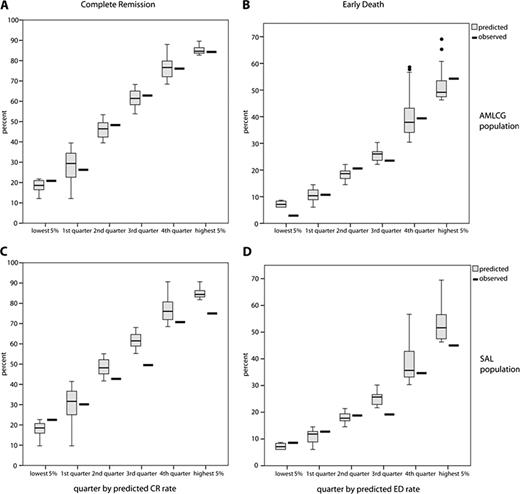Abstract
Abstract 2696
The prognosis of older patients (≥ 60 years) with acute myeloid leukemia (AML) is generally poor. The decision whether or not to use intensive chemotherapy in this patient cohort is challenging since only half of all older AML patients will eventually achieve a complete remission (CR) with an intensive approach. We therefore sought to develop a clinically relevant risk score for estimating the chance to obtain a CR compared to the risk of early death (ED).
1406 patients ≥ 60 years of age with AML and evaluable for an induction result after treatment with an intensive induction regimen (1-2 courses of either standard-dose araC containing TAD - high-dose araC containing HAM or HAM - HAM) within the AMLCG1999 study of the German AML Cooperative Group (AMLCG) were analyzed. External validation was performed on 801 patients ≥ 61 years of age treated in the AML96 study of the Study Alliance Leukemia (SAL) treated with 1–2 courses of a ‘7+3’ induction. 16 clinical parameters as well as cytogenetic and molecular risk factors were evaluated for risk prediction in an exploratory analysis.
Among the analyzed parameters, age, de novo versus secondary leukemia, body temperature, hemoglobin, thrombocyte count, LDH, fibrinogen and the cytogenetic and molecular risk were significantly associated with a CR and/or with an ED within 60 days (p<0.05) in a multivariate logistic regression analysis. For comparison, patients were grouped into quarters by their predicted CR and ED score. The comparison of the predicted with the observed CR and ED rates within these quarters and additionally within the highest and lowest 5% showed a valid prediction of the CR and ED rates by the individual risk prediction (figure 1A & B). This could also be demonstrated when applying these CR and ED scores on an independent patient population (figure 1C &D).
These scores based on pretreatment clinical, cytogenetic and molecular variables provide a reasonable estimate for CR and the ED rate of elderly AML patients. An online calculation tool for the prediction of the CR and the ED rate has been implemented (www.aml-score.org). This tool might be helpful to determine the treatment strategy for older patients with AML.
Comparison of the predicted CR and ED rate with the corresponding observed CR and ED rates. Patients were grouped into quarters by their predicted CR or ED rates and the boxplot of the predicted rate of each quarter is plotted against the observed rate of this quarter. In addition, the predicted versus the observed rates of the extreme 5% by predicted rates are shown. A: AMLCG population, CR rates; B: AMLCG population, ED rates; C: SAL population, CR rates; D: SAL population, ED rates.
Comparison of the predicted CR and ED rate with the corresponding observed CR and ED rates. Patients were grouped into quarters by their predicted CR or ED rates and the boxplot of the predicted rate of each quarter is plotted against the observed rate of this quarter. In addition, the predicted versus the observed rates of the extreme 5% by predicted rates are shown. A: AMLCG population, CR rates; B: AMLCG population, ED rates; C: SAL population, CR rates; D: SAL population, ED rates.
Comparison of the predicted CR and ED rate with the corresponding observed CR and ED rates. Patients were grouped into quarters by their predicted CR or ED rates and the boxplot of the predicted rate of each quarter is plotted against the observed rate of this quarter. In addition, the predicted versus the observed rates of the extreme 5% by predicted rates are shown. A: AMLCG population, CR rates; B: AMLCG population, ED rates; C: SAL population, CR rates; D: SAL population, ED rates.
Haferlach:MLL Munich Leukemia Laboratory: Employment, Equity Ownership. Haferlach:MLL Munich Leukemia Laboratory: Employment, Equity Ownership, Research Funding.
Author notes
Asterisk with author names denotes non-ASH members.


This feature is available to Subscribers Only
Sign In or Create an Account Close Modal